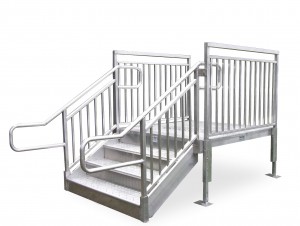Industrial plants often feature piping, electrical wires or boxes, heavy-duty machinery, or other items that might obstruct a floor plan. Crossover stairs can help people go over these obstacles while staying safe. It’s safer to use crossover stairs for these parts of industrial plants than if you asked employees to be cautious around specific spaces. REDD Team can assist you in producing new crossover stairs for any area in your plant that requires help.
 You’ll require enough materials for your stairs to conform to OSHA guidelines. We will analyze your situation and develop new stairs that fit your space while meeting these OSHA rules. The work includes planning multiple parts of a staircase to allow people to safely go up and down while offering enough room for crossing over something on the ground.
You’ll require enough materials for your stairs to conform to OSHA guidelines. We will analyze your situation and develop new stairs that fit your space while meeting these OSHA rules. The work includes planning multiple parts of a staircase to allow people to safely go up and down while offering enough room for crossing over something on the ground.
How Do Crossover Stairs Work?
Your crossover stairs will include a few parts to keep everything working:
- The platform
The platform in the middle of your crossover stairs will connect the two halves. This walking surface will feature a sturdy aluminum body that can handle many times its weight. The platform can be as long as necessary to ensure people can go over certain obstacles on your floor plan.
- Guardrails
Guardrails will go on the sides of your platform to keep people from falling off. The rails must be high enough to where people can use these rails as handlebars when walking if necessary.
- Stairs
You’ll require stairs on both sides of your platform. These stairs can be sized to meet OSHA standards, including ensuring there is not too much of a height shift between each step. Additional rest platforms may also appear in each stairwell in cases where they go for a little longer.
- Anchors
Some anchors will go under the stairs to keep everything in place while reinforcing their bodies. These anchors can go under the stairs because people aren’t as likely to walk under them as they would go under the platform.
- Handrails
Handrails are also necessary for the sides of the stairs. The handrails should be about 36 inches high, which is enough for most people to safely grab while providing a space for keeping people from falling.
- Landings on the top and bottom parts of the stairs
You’ll also require a safe landing on each end of the stairs to allow people to safely transfer on and off the stairs.
What Can Your Stairs Go Over?
Your crossover stairs can be as long as necessary. Let us know about what equipment or items your stairs will go over, and we’ll build your surfaces at our factory in the United States and then deliver them to your space for installation.
Your stairs can go over many surfaces:
- Large pipes, including ones for air and liquid
- Generators, batteries, and other mechanical items
- Separate walkways
- Large openings around a surface; this point works best for outdoor sites
- General open meeting areas
Let us know about your plans for developing stairs, and we’ll find a solution.
REDD Team is here to help you prepare and install new crossover stairs for your workers to use at industrial plants. These stairs are critical for keeping people safe by preventing them from walking into various obstacles or other items in the workplace. You can reach us online to schedule a visit or call us at (800) 648-3696 for further help.

